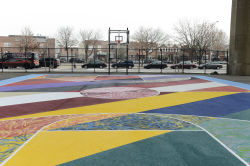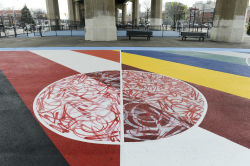Triborough Bridge Playground B
Triborough Bridge Playgrounds
The Triborough Bridge’s 13,829 feet of roadway viaduct, which runs over three steel bridges, spans the waters between Manhattan, the Bronx, and Queens. Edward A. Byrne, the chief engineer of the City Department of Plant and Structures, first announced plans for connecting the three boroughs in 1916, but the project did not receive funding until 1925. Construction of the bridge, designed by Othmar H. Ammann and architect Aymar Embury II, commenced on October 25, 1929, the “Black Friday” of the great stock market crash.
During the ensuing economic crisis, investors refused to purchase unstable municipal bonds, and all construction halted as the City found itself without adequate funds. Work on the bridge was at a standstill until 1932, when Robert Moses (1888-1981), serving as chairman of the State Emergency Public Works Commission, made it a top priority.
In early 1933, Moses drafted legislation that formed the Triborough Bridge Authority (TBA), a temporary public-benefit corporation, to be dismantled after paying for the bridge. By selling its bonds exclusively to the New Deal-era Reconstruction Finance Corporation, and later, the Public Works Administration, the TBA would have served as a short-term crutch to help rebuild the economy during the Great Depression. In reality, however, the TBA never stopped selling bonds or closed down, due to a clever loophole that Moses wrote into the TBA charter.
On July 11, 1936, after seven years of stilted construction and $60 million worth of expenses, the Triborough Bridge opened to traffic. The main span carries cars 2,780 feet from Queens to Ward’s Island, 143 feet above the river. A 700-foot lift bridge connects Randalls Island and 125th Street in Manhattan, and a 1,217 foot-long truss bridge links Randalls Island to the Bronx. In addition to its three main elements, the complex structure comprises a number of smaller bridges and viaducts and 14 miles of approach highways and parkways, with parks and recreational facilities inserted wherever possible.
During its first year, the bridge carried 9,650,000 vehicles, and generated $2,720,000 in tolls. Under the direction of Robert Moses, the well-funded TBA grew steadily and eventually became the Triborough Bridge and Tunnel Authority, which was eventually merged with the Metropolitan Transportation Authority (MTA).
The City first acquired the land that now constitutes the six Triborough Bridge Playgrounds in two parcels in 1931, for the TBA. The Authority surrendered the land to Parks on May 7, 1937 -- ten months after the Triborough Bridge had opened to the public. The six Triborough Bridge Playgrounds, located on Hoyt Avenue North and Hoyt Avenue South between 21st and 26th streets, provide the surrounding neighborhood with a variety of recreational facilities. Visitors enjoy six basketball and six handball courts, several jungle gyms and swing sets, open play areas, a concrete frog sprinkler system, a public restroom, and numerous sitting areas with benches and trees.
Check out your park's Vital Signs
Clean & Safe
Green & Resilient
Empowered & Engaged Users
Share your feedback or learn more about how this park is part of a
Vital Park System








